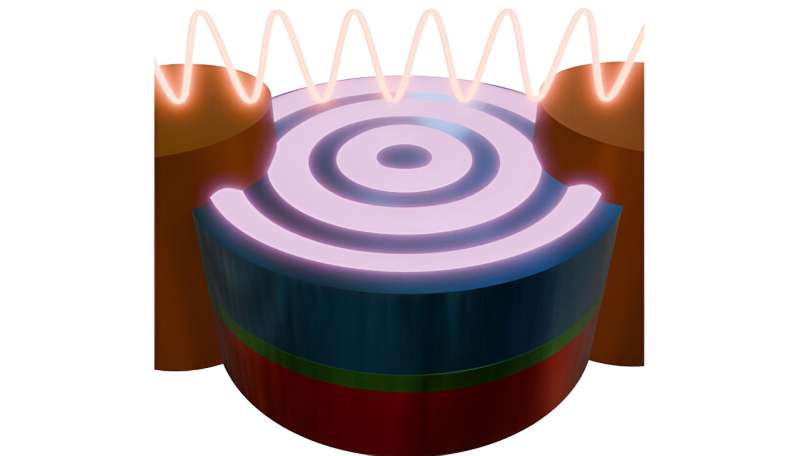A new study conducted at the University of Vienna, the Max Planck Institute for Intelligent Systems in Stuttgart, and the Helmholtz Centers in Berlin and Dresden takes an important step in the challenge to miniaturize computing devices and to make them more energy-efficient.
The work, published in Science Advances, opens up new possibilities for creating reprogrammable magnonic circuits by exciting spin waves by alternating currents and redirecting these waves on demand.
The central processing units (CPUs) that we use in our laptops, desktops or even phones use billions of transistors, which are based on the complementary metal oxide semiconductor (CMOS) technology. With the increasing need to miniaturize these devices, several physical limitations are raising concerns about their sustainability. In addition, high power consumption and energy losses push scientists to search for alternative computing architectures.
One of the promising candidates are magnons, the quanta of spin waves. “Imagine a calm lake. If we let a stone fall into water, the resulting waves will propagate away from the point of generation. Now, we replace the lake with a magnetic material and the stone with an antenna. The propagating waves are called spin waves and can be used to transfer energy and information from one point to another with minimal losses,” says Sabri Koraltan from the University of Vienna, first author of the recent study.
Once generated, the spin waves can be used for magnonic devices to perform classical and unconventional computing tasks. “To reduce the footprint of magnonic devices, we need to use spin waves with short wavelengths, which are difficult to generate using state-of-the-art nano antennas due to limited efficiency,” adds Sebastian Wintz from Helmholtz-Zentrum Berlin and the coordinator of the research project.
Nano antennas can only be fabricated in clean rooms, highly specialized nanofabrication facilities, using advanced lithography techniques.
In a major leap forward, the researchers from Austria and Germany came up with a much simpler solution: The electric current flows directly through a magnetic stack with swirling magnetic patterns. “Our research shows that by using a lateral alternating current geometry in synthetic ferrimagnetic vortex pairs, we can achieve spin-wave emission with an efficiency that surpasses conventional methods by several orders of magnitude,” says Koraltan.
Synthetic ferrimagnetic systems have opposite magnetization patterns. If the upper layer has a clockwise rotating vortex, the lower layer has an anticlockwise sense of rotation. This enables the efficient excitation of the magnetization pattern using the magnetic fields generated by the alternating currents.
“Using our high-resolution ‘Maxymus’ X-ray microscope, based at the BESSY II electron synchrotron in Berlin, we were even able to observe the predicted spin waves at nanoscale wavelengths and Gigahertz frequencies,” adds Wintz.
“Moreover, by incorporating special materials, which can change their magnetization when a strain is applied, we have demonstrated that the direction of these spin waves can be dynamically steered by simply adjusting the magnitude of the applied current. This can be regarded as an important step towards active magnonic devices,” states Koraltan.
“Our new generation of micromagnetic simulation software, magnum.np, allowed us to perform large-scale simulations, which were crucial to understand the main mechanisms behind this efficient and controllable spin-wave excitation,” adds Dieter Süss, head of the Physics of Functional Materials Department at the University of Vienna.
The ability to redirect spin waves on demand opens up new possibilities for creating reprogrammable magnonic circuits, which could lead to more adaptable and energy-efficient computing systems. The findings represent a major advancement in finding new ways to generate magnons for possible next-generation magnon-based technologies.
More information:
Sabri Koraltan et al, Steerable current-driven emission of spin waves in magnetic vortex pairs, Science Advances (2024). DOI: 10.1126/sciadv.ado8635
Provided by
University of Vienna
Citation:
Alternating currents for alternative computing with magnets (2024, September 26)
retrieved 26 September 2024
from https://phys.org/news/2024-09-alternating-currents-alternative-magnets.html
This document is subject to copyright. Apart from any fair dealing for the purpose of private study or research, no
part may be reproduced without the written permission. The content is provided for information purposes only.

